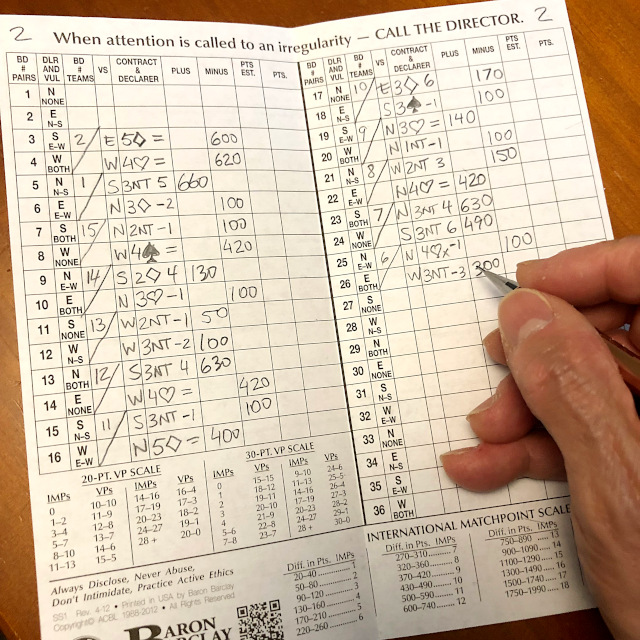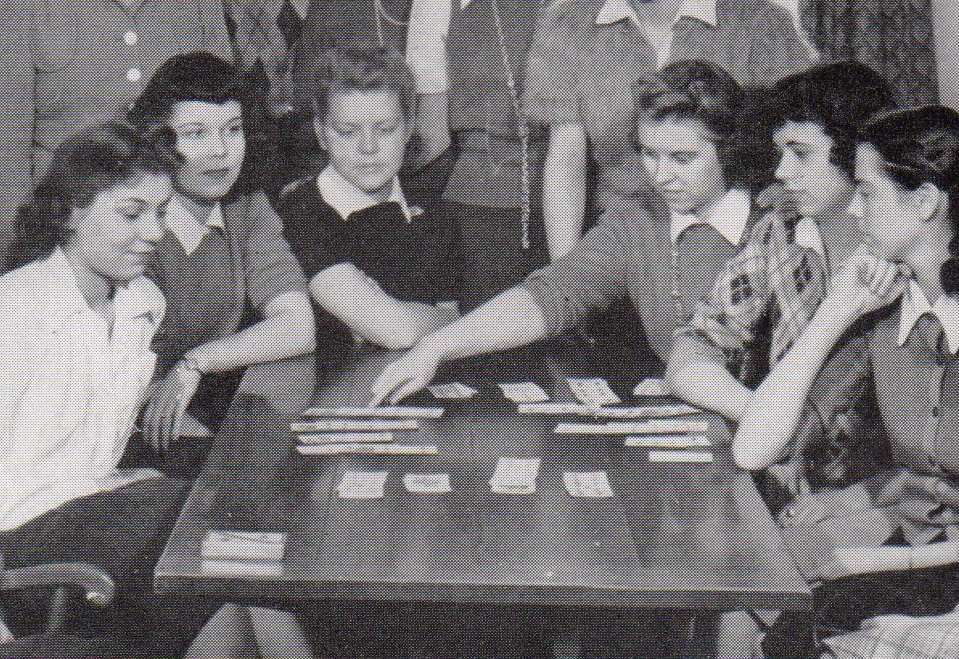|
Singaporean Bridge
Singaporean bridge (also known as floating bridge) is a re-invention of the traditional game of contract bridge deriving its name from where it is believed to have been invented, Singapore. There are many variations to the game which is primarily social, has no official book of rules and no formal organizing authority. Introduction Players assume fixed seats, but unlike contract bridge, the partners are not determined at the outset by virtue of prior pairing — they are determined at the end of the bidding. Using a standard 52-card deck, each player is dealt thirteen cards. There is a round of bidding to establish who is declarer, the trump suit, if any, and the number of tricks to be taken by declarer. Declarer then announces the rank and suit of a card and the holder of that card becomes declarer's undisclosed partner. Either declarer or the player on his left makes the first lead and normal trick-taking play ensues. Although declarer and his partner cooperate to take the mos ... [...More Info...] [...Related Items...] OR: [Wikipedia] [Google] [Baidu] |
Contract Bridge
Contract bridge, or simply bridge, is a trick-taking card game using a standard 52-card deck. In its basic format, it is played by four players in two competing partnerships, with partners sitting opposite each other around a table. Millions of people play bridge worldwide in clubs, tournaments, online and with friends at home, making it one of the world's most popular card games, particularly among seniors. The World Bridge Federation (WBF) is the governing body for international competitive bridge, with numerous other bodies governing it at the regional level. The game consists of a number of , each progressing through four phases. The cards are dealt to the players; then the players ''call'' (or ''bid'') in an auction seeking to take the , specifying how many tricks the partnership receiving the contract (the declaring side) needs to take to receive points for the deal. During the auction, partners use their bids to also exchange information about their hands, including o ... [...More Info...] [...Related Items...] OR: [Wikipedia] [Google] [Baidu] |
Singapore
Singapore (), officially the Republic of Singapore, is a sovereign island country and city-state in maritime Southeast Asia. It lies about one degree of latitude () north of the equator, off the southern tip of the Malay Peninsula, bordering the Strait of Malacca to the west, the Singapore Strait to the south, the South China Sea to the east, and the Straits of Johor to the north. The country's territory is composed of one main island, 63 satellite islands and islets, and one outlying islet; the combined area of these has increased by 25% since the country's independence as a result of extensive land reclamation projects. It has the third highest population density in the world. With a multicultural population and recognising the need to respect cultural identities of the major ethnic groups within the nation, Singapore has four official languages: English, Malay, Mandarin, and Tamil. English is the lingua franca and numerous public services are available only in Eng ... [...More Info...] [...Related Items...] OR: [Wikipedia] [Google] [Baidu] |
Contract Bridge Glossary
These terms are used in contract bridge, using duplicate or rubber scoring. Some of them are also used in whist, bid whist, the obsolete game auction bridge, and other trick-taking games. This glossary supplements the Glossary of card game terms. : ''In the following entries,'' boldface links ''are external to the glossary and'' plain links ''reference other glossary entries.'' 0–9 ;: A mnemonic for the original (Roman) response structure to the Roman Key Card Blackwood convention. It represents "3 or 0" and "1 or 4", meaning that the lowest step response (5) to the 4NT key card asking bid shows responder has three or zero keycards and the next step (5) shows one or four. ;: A mnemonic for a variant response structure to the Roman Key Card Blackwood convention. It represents "1 or 4" and "3 or 0", meaning that the lowest step response (5) to the 4NT key card asking bid shows responder has one or four keycards and the next step (5) shows three or zero. ;1RF: One round forc ... [...More Info...] [...Related Items...] OR: [Wikipedia] [Google] [Baidu] |
Standard 52-card Deck
The standard 52-card deck of French-suited playing cards is the most common pack of playing cards used today. In English-speaking countries it is the only traditional pack used for playing cards; in many countries of the world, however, it is used alongside other traditional, often older, standard packs with different suit systems such as those with German-, Italian-, Spanish- or Swiss suits. The most common pattern of French-suited cards worldwide and the only one commonly available in Britain and the United States is the English pattern pack. The second most common is the Belgian-Genoese pattern, designed in France, but whose use spread to Spain, Italy, the Ottoman Empire, the Balkans and much of North Africa and the Middle East.''Pattern Sheet 80'' at i-p-c-s.org. Retrieved 23 August 2020. In addition to those, there are other major in ... [...More Info...] [...Related Items...] OR: [Wikipedia] [Google] [Baidu] |
Playing Card
A playing card is a piece of specially prepared card stock, heavy paper, thin cardboard, plastic-coated paper, cotton-paper blend, or thin plastic that is marked with distinguishing motifs. Often the front (face) and back of each card has a finish to make handling easier. They are most commonly used for playing card games, and are also used in magic tricks, cardistry, card throwing, and card houses; cards may also be collected. Some patterns of Tarot playing card are also used for divination, although bespoke cards for this use are more common. Playing cards are typically palm-sized for convenient handling, and usually are sold together in a set as a deck of cards or pack of cards. The most common type of playing card in the West is the French-suited, standard 52-card pack, of which the most widespread design is the English pattern, followed by the Belgian-Genoese pattern. However, many countries use other, traditional types of playing card, including those that are German ... [...More Info...] [...Related Items...] OR: [Wikipedia] [Google] [Baidu] |
Duplicate Bridge
Duplicate bridge is a variation of contract bridge where the same set of bridge deals (i.e. the distribution of the 52 cards among the four hands) are played by different competitors, and scoring is based on relative performance. In this way, every hand, whether strong or weak, is played in competition with others playing identical cards, and the element of skill is heightened while that of chance is reduced. This stands in contrast to Bridge played without duplication, where each hand is freshly dealt and where scores may be more affected by chance in the short run. Four-way card holders known as Bridge boards are used to enable each player's hand to be preserved from table to table, and final scores are calculated by comparing each pair's result with others who played the same hand. In duplicate bridge, players normally play all the hands with the same partner, and compete either as a partnership (in a 'Pairs tournament') or on a team with one or more other partnerships ('Te ... [...More Info...] [...Related Items...] OR: [Wikipedia] [Google] [Baidu] |
Ruff (cards)
In trick-taking games, to ruff means to play a trump card to a trick (other than when trumps were led). According to the rules of most games, a player must have no cards left in the suit led in order to ruff. Since the other players are constrained to follow suit if they can, even a low trump can win a trick. In some games, like Pinochle and Preferans, the player who cannot follow suit is required to ruff. In others, like Bridge and Whist, he may instead discard (play any card in any other suit). Normally, ruffing will win a trick. But it is also possible that a subsequent player will overruff (play a higher trump). Historically, ruff meant to "rob" i.e. exchange a card with the stock. Usage of the word "ruff" vs. "trump" "Ruff" is normally a verb, meaning "to play a trump card when a non-trump suit was led". "To trump" can be used as a synonym of "to ruff", but "ruff" is normally preferred, for clarity. As a noun, "ruff" and "trump" are completely different – "a ruff" means onl ... [...More Info...] [...Related Items...] OR: [Wikipedia] [Google] [Baidu] |
Trump (card Games)
A trump is a playing card A playing card is a piece of specially prepared card stock, heavy paper, thin cardboard, plastic-coated paper, cotton-paper blend, or thin plastic that is marked with distinguishing motifs. Often the front (face) and back of each card has a fi ... which is elevated above its usual rank in trick-taking games. Typically, an entire Suit (cards), suit is nominated as a ''trump suit''; these cards then outrank all cards of plain (non-trump) suits. In other contexts, the terms ''trump card'' or ''to trump'' refers to any sort of action, authority, or policy which automatically prevails over all others. Etymology The English word '':wikt:trump, trump'' derives from ''Trionfi (cards), trionfi'', a type of 15th-century Italian playing cards, from the Latin '':wikt:triumphus, triumphus'' "triumph, victory procession", ultimately (via Etruscan) from Greek Thriambus, θρίαμβος, the term for a hymn to Dionysus sung in processions in his honour. ''Trion ... [...More Info...] [...Related Items...] OR: [Wikipedia] [Google] [Baidu] |
Contract Bridge
Contract bridge, or simply bridge, is a trick-taking card game using a standard 52-card deck. In its basic format, it is played by four players in two competing partnerships, with partners sitting opposite each other around a table. Millions of people play bridge worldwide in clubs, tournaments, online and with friends at home, making it one of the world's most popular card games, particularly among seniors. The World Bridge Federation (WBF) is the governing body for international competitive bridge, with numerous other bodies governing it at the regional level. The game consists of a number of , each progressing through four phases. The cards are dealt to the players; then the players ''call'' (or ''bid'') in an auction seeking to take the , specifying how many tricks the partnership receiving the contract (the declaring side) needs to take to receive points for the deal. During the auction, partners use their bids to also exchange information about their hands, including o ... [...More Info...] [...Related Items...] OR: [Wikipedia] [Google] [Baidu] |



